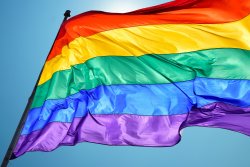What is Safe Space?
Safe Space programs have been established at various universities throughout the country. The LGBTQ decal signifies the displayer’s willingness to be supportive of LGBTQ people. The intended message of the symbol is that the person displaying this decal is one who will be non-judgmental, understanding and trustworthy should anyone need help, advice or conversation.
The primary goal of the Safe Space program is to create a network of support for the LGBTQ community at Montclair State through:
- Reflection
- Personal and professional development
- Education
- Action
While this program does focus on the lives experiences of LGBTQ people, education on LGBTQ issues, and challenges affecting college-aged LGBTQ people on our campus and nationally, this program is more centered on the attendees and their experiences with LGBTQ people and issues. Through interactive activates and discussion, participants will personally reflect on their own experiences to enhance their personal and professional development, provide further education, and finally, identify ways to create change on campus and beyond.
- Understand and identify your own privileges
- Differentiate between sex, gender identity, gender expression and sexual orientation
- Describe ways to create more inclusive environments on campus for LGBTQ people
- Utilize inclusive and affirming language regarding sexual and gender identities
- Be knowledgeable about referral services and resources
- Dispel stereotypes
- Create change on campus and beyond
- “I got to meet new people and learn from their experiences.”
- “This learning really changed my life and I am so excited to say that I am so excited to say that I now know how to be an ACTIVE ally!”
- “I was surprised at how interactive the training was! The time really flew by and so much information was covered!”
- “Every student should go through this training—it’s life-changing.”
Lesbian, gay, bisexual, transgender, queer, questioning, intersex, asexual, and other non-heterosexual and non-cisgender persons cannot be readily identified, unlike more visible under-represented groups. Similarly, there is no easy method of finding persons supportive of LGBTQ+ people. As one component of the LGBTQ Center at Montclair State, the Safe Space program strives to provide a way for supportive persons within the University community to prominently identify themselves and provide a visible network of support for the LGBTQ+ community.
Unfortunately, no. All registrants must have a Montclair State CWID number because our training is only for the Montclair State community. However, we can work with you and your organization to bring a training to you. For more information on this, email jacksoneb@montclair.edu.
The most important thing is that you will encounter a person you can talk to who is non-judgmental, understanding and trustworthy. Good listening and support can be expected. The creation of a sense of safety can contribute to a sharing of feelings and learning about LGBTQ people. Your discussion will be confidential. If you’re speaking about a problem you’ve encountered at Montclair State University you can expect a person in a Safe Space to help you find out what to do about that problem. If needed, you can obtain names of resources on campus and in the community for emotional support, legal advice, health services and social contact, and information about organizations in the LGBTQ community.
The individuals whose office you are visiting will not be your counselor. There will be no pressure to take action or change your life or lifestyle. There will just be support.
The LGBTQ Safe Space Program was established at Montclair State University in 1997 and was originally sponsored by the Gay and Lesbian Faculty and Staff Association of Montclair State University (GLFSA), Health Promotion, and the Student Development and Campus Life Division of the Office of the Dean of Students. It was announced to the campus community on National Coming Out Day and its existence has been publicized through campus publications and the Office of Student Services. In addition to providing support to LGBTQ people on campus, this program also educated the campus about the problems of homophobic harassment and the needs of gay, lesbian, bisexual, transgender, queer and questioning people for support and inclusion. The program is currently sponsored by the Lesbian, Gay, Bisexual, Transgender, Queer Center.
Old symbol (designating the curriculum prior to 2013)
During the Holocaust, pink triangles were used by the Nazis to label gay men and black triangles were used to label lesbians and other “anti-socials.” These symbols have been adopted as symbols of identity, pride and self-esteem for the gay and lesbian community. The area bisected these triangles represents the diversity of sexual “minorities” which includes bisexuals. The interconnectedness of human sexuality is thereby represented. The green circle, the opposite of the familiar red circle with a slash, signifies the displayer’s willingness to be supportive of GLBTQ people. It also represents the inclusion of straight allies of these communities.
New symbol (2013 curriculum on)
The Rainbow Flag made its first appearance in the San Francisco Gay and Lesbian Freedom Day Parade in 1978 and was designed by artist Gilbert Baker. The original flag had eight stripes, with each color representing a particular component of the gay community: hot pink for sex, red for life, orange for healing, yellow for sun, green for nature, turquoise for the arts, indigo for harmony, and violet for spirit. Two changes occurred to the original flag: hot pink and turquoise stripes were removed. The colors are now: red, orange, yellow, green, blue, purple.
